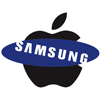In the continuing drama of Apple vs. Samsung, a Samsung expert witness, (read that as “hired gun”), says the Cupertino company’s design patents should be invalidated due to prior art. Itay Sherman took the stand to discuss Apple design patents covering the front face of the iPhone, and the patent that covers the iPad design.
Sherman showed four examples of prior art when discussing the iPhone, including two Japanese design patents, a Korean design patent, and the LG Prada — all of which pre-dated the iPhone. All of the examples feature rectangular shapes with rounded corners and centered screens. When taken together, Sherman said, they meant Apple’s patented designs were not unique.
As to the iPad design, Sherman referenced two physical devices, the Compaq TC1000 tablet computer, and a mock-up put together in 1994 by Roger Fidler. While the iPad patent specifies a device with a front face with edge-to-edge glass, the Fidler design featured a frame with an inset screen. By combining the TC1000’s front face with the Fidler concept, Sherman said, then you get the elements of the iPad patent. Voila! The iPad design should not be protected either.
Design patents are for ornamental elements, not strictly functional, which Sherman said invalidated Apple’s patents. He stated the design elements of Apple’s patents were utilitarian, the rounded corners of the device make it easy to hold, also make the device easier to pull from your pocket.
Apple’s legal team took that statement as an opportunity to attack. They showed Sherman several other phones on the market, and forced him to admit that any type of rounded corners would provide the benefits he described, not just the specific degree of rounding Apple is accusing Samsung of copying.
The team also displayed a Nokia Lumina device, saying it was an example of a device that doesn’t use any of the discussed iPhone design elements, in an attempt to counter the idea that Apple’s choice or rounding was a functional necessity.



